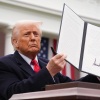President Donald Trump speaks with reporters on the White Home on Aug. 11, 2025, in Washington.
Alex Brandon/AP
conceal caption
toggle caption
Alex Brandon/AP
President Trump prolonged a truce between the U.S. and China on tariffs, a transfer that would probably set the stage for a summit with Chinese language chief Xi Jinping later this yr.
With hours left on the clock earlier than the looming midnight Tuesday deadline, Trump’s government order acknowledged that China was taking “significant steps” towards addressing American considerations on “economic and national security matters.” Beijing introduced the truce extension on the identical time.
Permitting the truce to run out would have despatched tariff charges for each international locations skyrocketing, dealing a serious blow to commerce between the world’s two largest economies. The U.S. will preserve its normal tariff price on Chinese language items at 30%, and China will preserve its personal price on American items at 10%.
The extension offers the 2 sides an extra 90 days to iron out their variations on a spread of points as Trump seeks to reshape the worldwide economic system in favor of bringing manufacturing again to the U.S. It additionally arrives because the U.S. proclaims a number of commerce agreements with international locations together with South Korea and Japan on the one hand, whereas it levies steep tariffs on a number of nations on the opposite — for instance, Trump has threatened to lift U.S. tariffs to 50% on Indian exports to the U.S. later in August, on account of that nation’s continued purchases of Russian oil.
“Today’s news all-round stabilizes the situation, increases confidence for American consumers, for importers of goods who sell those goods in the U.S., and for manufacturers in China,” stated David Meale, the pinnacle of Eurasia Group’s China Division and a former diplomat and deputy chief of mission for the U.S. Embassy in Beijing. “I think it is very likely the U.S. and China will come to some kind of trade arrangement, and the next steps are likely to be driven by the prospect of a leaders’ meeting between President Trump and President Xi later this fall.”
Meale says he thinks the following steps for each side will contain extra conferences between commerce and financial officers like those held in Stockholm final month, to put the groundwork for an eventual face-to-face assembly and a extra concrete commerce settlement which might be signed earlier than the most recent truce expires on Nov. 10.
Shortly following his inauguration, Trump relaunched a commerce conflict that he began in his first time period, asserting tariff hikes on China. Beijing responded with its personal reciprocal tariffs and export controls on uncommon earth minerals comparable to bismuth and tungsten, that are a vital element of most electronics. A sequence of price hikes and responses continued by means of March and April, with U.S. tariffs on Chinese language imports finally reaching 145%, and China’s tariffs for U.S. exports climbing to 125%.
At a gathering in Geneva in Might, nonetheless, tensions cooled when the 2 sides introduced a 90-day truce, with each international locations reducing tariff charges and easing different commerce limitations together with deliveries of Chinese language uncommon earth minerals. However each side quickly accused the opposite of failing to honor the phrases of the settlement.
The 2 sides held two days of talks in Stockholm final month however left with out agreeing to a deal. Following the talks, U.S. Treasury Secretary Scott Bessent advised CNBC he believed the U.S. and China had reached “the makings of a deal” and that “There’s still a few technical details to be worked out on the Chinese side between us. I’m confident that it will be done, but it’s not 100% done.” Bessent added that the ultimate resolution on approving any deal lay with President Trump.
Negotiations between the U.S. and China have been complicated and included a number of points, starting from American considerations about Chinese language overproduction and purchases of Russian oil to Chinese language complaints about Washington’s resolution to restrict exports of semiconductors that China must energy AI programs.
Meale says the American precedence for these negotiations will probably be to decrease its commerce deficit with China, to safe and diversify its provide chains away from reliance on China and to verify the stream of uncommon earth minerals from China will probably be secure. There will probably be important tariffs on Chinese language items coming into the U.S. “when this is all over,” Meale predicts.
China, Meale says, is “looking for stability” in its relationship with the U.S., because it faces a slower-growing economic system and seeks a extra predictable surroundings for its companies. Meale says China will even attempt to preserve its entry to American applied sciences like higher-end semiconductors and jet engines.
Nicholas Lardy, a nonresident fellow on the Peterson Institute for Worldwide Economics, additionally says a remaining U.S.-China commerce deal might embrace easing of know-how restrictions, and a much less doubtless risk is likely to be Chinese language guarantees to put money into U.S. manufacturing. Lardy provides that even when each side make progress and attain a deal, in Trump’s imaginative and prescient, “bilateral trade would shrink considerably, beyond what we have already seen.”
Though the truce relieved the worst of the commerce tensions, commerce between the U.S. and China has demonstrably fallen since early this yr. China’s July export knowledge confirmed its exports to the U.S. had fallen year-over-year for the fourth month in a row, and China’s imports from the U.S. fell by 10.3% from the January to July interval.







